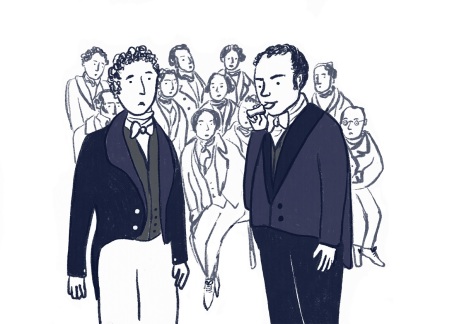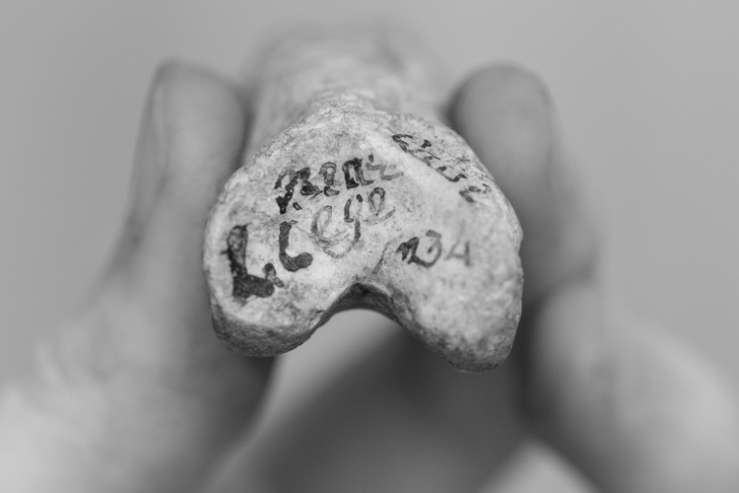
by Anna Dewar, Museum intern
Victorian geologist William Buckland had an impressive knack for finding fossils. He named the first dinosaur, Megalosaurus bucklandii, in 1824 after its discovery in Stonesfield near Oxford. You can see the Megalosaurus fossils on display in the Museum today.
Working as an intern here over the last few weeks, I have been confronted with hundreds of Buckland’s specimens, many of which have never been catalogued.
A couple of weeks ago I stumbled upon a cave bear toe bone, or phalanx, with a very unusual label. Written in Buckland’s handwriting was ‘Cave Bear Liège’ and the number ‘234’. No other fossils in this collection were numbered, and after a database search not one other specimen had been found near this Belgian city.
I then discovered something that, while it could be coincidence, demanded further investigation. On page 234 of Lyell’s Principles of Geology, Vol. II, published in 1832, appears the only mention of Liège in the entire book:
In several caverns…near Liège, Dr. Schmerling has found human bones in the same mud…with those of the…bear, and other… extinct species.
The mysterious ‘234’ perhaps references this page number; if so, it would indicate that the specimen was one of those Philippe-Charles Schmerling had discovered. But if this is the case, how did this fossil end up in Buckland’s possession?

After some further research, I learned that Schmerling presented his Liège findings to a group of naturalists including Buckland in 1835. Schmerling argued that the human bones he had discovered were also fossils, and so the same age as the bones of extinct animals.
Buckland countered Schmerling’s claim by saying that “these animals lived and died before the creation of man” and that, instead, the human remains found alongside extinct species could be explained by burial. French geologist Élie de Beaumont, who was present at the meeting, remembered how Buckland chose to voice this opinion:
Mr Buckland took a bear bone, and put it on the tip of his tongue, to which it remained suspended…and, turning to…the assembly, Mr Buckland repeated many times…: ‘You say that it does not stick to the tongue!’ Mr Schmerling tried a few times to stick to his own tongue several human bones, but he did not succeed.

An entirely speculative artist’s impression of William Buckland’s ‘tongue test’ demonstration
Whilst speaking to a crowd with a fossil on your tongue seems odd, Buckland did have reason. It was difficult to estimate the age of a specimen, and this ‘tongue test’ supposedly related to the mineralisation of the bone: if it stuck to your tongue, it was a fossil; if it didn’t stick, it was bone.
While Schmerling was left humiliated, it was realised after his death that he had found human fossils after all, including those of a Neanderthal. Obviously the tongue test was not as foolproof as Buckland believed.
While we’ll never know for sure, Buckland, by writing ‘234’, may have linked this bone from Liège to Schmerling. It also happens to be a bear bone, small enough that it could conceivably adhere to a tongue. Could Buckland have slipped it into his pocket after his demonstration? Or perhaps for Schmerling, the bone, after having been coated in Buckland’s saliva while he himself stood humiliated, may have somewhat lost its appeal.
Whether or not this bone is THE bone at the heart of this spectacle, it does seem that life as a palaeontologist in the 19th century certainly wasn’t boring.



Dear Anna,
Thank you for this lovely story. Please can it be printed out and put with the bear bone in a display cabinet for us to enjoy as a visitor to the museum and not just on line.
Also, completely unrelated, but whilst I am corresponding with the museum. Is there any chance that a scorpion could be put in the immunofluorescence cabinet. I saw one once at an exhibition of immunofluorescence at Edinburgh and they fluoresce beautifully. Thank you.
Best Wishes
Hi Judith. Thanks a lot for your suggestions. Regarding a display of the bone I think it might work in our changing themed ‘Presenting…’ series (http://www.oum.ox.ac.uk/visiting/presentintro.htm), so I’ll add the idea to the list.
For the scorpion, you’re right their fluorescence is remarkable, under UV light I think? Is the cabinet that you’re referring to the minerals ‘tent’ in the museum? If so, it’s focus is specifically minerals, but we could perhaps include a scorpion and UV lamp in our entomology displays.